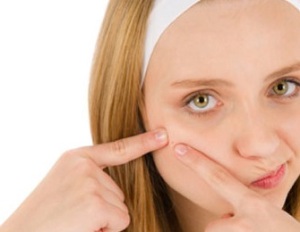
So you want beautiful skin? Truly radiant, glowing, and possibly even younger-looking skin? Then you need to make sure what you put in your body is as carefully chosen as what you put on it! When trying to achieve your skin care goals, it takes more than just what you put on your skin. Relying on products to give you the results you want without taking care of yourself on the inside is as effective as taking diet pills and eating fast food for every meal—you’re simply not going to achieve the results you want!
Everything you eat affects your whole body, from the inside out. Your skin is your largest organ, and how you nourish it shows. If you starve, suffocate, or deny its needs long enough your skin could end up looking older, sallow, dull, and even cause medical problems like acne or eczema.
For optimal skin health from the inside out, most experts agree a balanced, healthy diet goes a long way. Here are five things you can add to your diet (in moderation!!!) to go the extra mile for your skin:
1. Vitamin A – Vit A is a fat-soluble nutritional compound essential for growth and development, helps to support your immune system, and keeps your vision top-notch. Vitamin A is also your body’s natural source for retinol. Retinol is sort of like a house-mom for your skin cells. It tells them how look, act, and behave better while keeping other substances from telling your cells to behave abnormally. This communication with your cells helps prevent and heal blemishes, fine lines, wrinkles, discoloration, and general dullness. It can make your skin a bit sun sensitive though, but you’re already staying out of the sun anyway, right? 😉
Best Sources: Whole milk, yogurt, and other dairy products are arguably the best source for vitamin A, but if you have a dairy allergy or do not eat animal products you can also get vitamin A from sweet potatos, carrots, dark leafy greens, winter squash, and swiss chard. However, for all you skinny minnies who don’t eat any fat, you’re going to need to add a little fat back into your diet when you eat sources of vitamin A, or else your body will be unable to absorb this fat-soluble vitamin.
2. Essential fatty acids – These are abbreviated as EFA’s, and they refer to fatty acids that are required for biological processes—you would die if you didn’t have them in your diet! They are considered “essential” because our bodies are not capable of synthesizing them, which is a fancy way of saying that your body cannot produce these fatty acids by combining other nutrients in your diet. There are only two known EFA’s for humans: alpha-linolenic acid (an omega-3 fatty acid) and linoleic acid (an omega-6 fatty acid). As an interesting side note, EFA’s were originally designated “vitamin F” but research eventually showed they were better classified as a fat than a vitamin.
Essential fatty acids are responsible for maintaining healthy cell membranes. Your cell membranes act as the guardians of your cells, which means that their job is to allow good things in (like the nutrients your cells need) while keeping the bad things out (like toxins), so it’s easy to see why it’s important to have properly functioning and healthy cell membranes. They also allow waste products to get in and out of the cell, a necessary function to life. The cell membrane also holds water in, so the stronger that barrier is, the better your cells can hold moisture. More moisture in your skin means plumper, younger looking skin. Also, the same inflammatory process that harms your arteries and causes heart disease can damage skin cells. Increasing your intake of EFAs is a critical step to healthier, younger looking skin—and your body in general.
Best Sources: Salmon, walnuts, flax seed, sardines, and fish oil supplements (with a high EPA/DHA content!)

A photo of an older man showing skin inflammation caused by not getting the proper nutrients. Looking at his plate, it’s not a surprise.
3. Healthy Oils – Eating high-quality oils helps to keep skin lubricated and looking and feeling healthier overall. It’s best to look for oils labeled cold pressed, expeller processed, or extra virgin to ensure you get all the healthy nutrients and compounds in these oils. When an oil is commercially processed, important nutrients are often lost via the solvents and heating used in these processes.
Best Sources: Olive, palm, and coconut oils. Ghee (clarified butter), duck fat and butter from grassfed cows are skin healthy sources of animal fats—and grassfed butter and duck fat are both rich sources of EFAs, too! Since these are all very high in fat, moderation should of course be exercised. I prefer to cook with animal fats and coconut oil—not only are they immensely delicious, but they are stable under high heat. Olive and palm oils can oxidize when heated, which can be damaging to your cells, as you’ll read right below.
4. Antioxidants – These help to prevent oxidation in the body (get it? ANTI-oxidant). Oxidation is actually a normal, natural cellular process, but sometimes the result is a very dangerous side effect—free radicals. Approximately 1-2% of cells that oxidize get damaged and turn into free radicals. The science behind free radicals isn’t important here, but what is important is that a free radical can injure other cells and damage its DNA, which has been linked to premature aging and other diseases, including cancer. Thus, it’s critical to be consuming antioxidants in your diet, which neutralize free radicals before they wreak havoc on your cells.
Best Sources: Blackberries, blueberries, strawberries, plums, green tea…..and chocolate, but that’s not a free pass!
5. Selenium – Selenium is a mineral that helps the skin heal from burn injures and protects from sun rays. It also has anti-inflammatory and antioxidant properties. It sort of plays the role of “Best Supporting Actor” to the other four skin healthy items we mentioned.
Best Sources: Tuna, shrimp, brazil nuts, and whole wheat products.
Getting your skin to be its healthiest starts from the inside. Skin care is 80% what you put in your body and 20% what you put on it. Products and estheticians can only get you so far if you’re not hydrating, and eating essential nutrients to your health.
As always, if you have any questions please email me at megjacobsblog@gmail.com, and I’d love to hear suggestions for future posts!
Don’t forget to follow on Facebook! www.facebook.com/megjacobsbeauty
See you next Sunday!

























